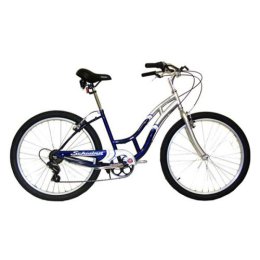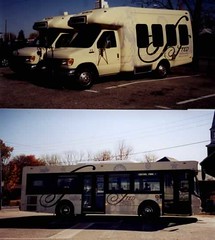Think different ... about mobility
 Schwinn Women’s Cruiser 26" Bike for sale at $99.99 on the Target website. Target employees get a 10% discount.
Schwinn Women’s Cruiser 26" Bike for sale at $99.99 on the Target website. Target employees get a 10% discount.When society is so focused on the car, it's hard to explore options in a focused and more broad-minded fashion. Take mobility. I get around the city of Washington (where I work and live) pretty much by bike.
Now some people say, "oh that saves you money." But it really doesn't. DC roads are not kind to bikes, neither are thieves. And I am not mechanically gifted so I pretty much pay for repairs and tuneups. So it costs about the same.
But what that doesn't take into account is the time I save. Rather than waiting for a bus or subway, for the most part I can ride where I need to go, when I want to. I figure that bike transportation saves me a minimum of 30 minutes/day (granted I waste that time blogging...).
Yesterday's Post, in "For the Carless, Life Is a Wait: Local Bus Systems Can Be Slow, but They Get There" recounts the story of Connie Wells in Fredericksburg, who takes a bus to work. She leaves up to three hours before she is supposed to be at work, to ensure she's on time. Unlike most people Ms. Wells actually lives pretty close to her job--it's three miles away.
From the article:
Connie Wells is waiting for the 1:10 p.m. bus outside her Fredericksburg apartment complex. Her cashier shift at Target doesn't start for nearly three hours, and she's only going three miles. But the next bus, in two hours, will get her there too late. So Wells is waiting, early -- very early -- to make it to a job she desperately needs.
Eventually, Bus No. 2 pulls up, a beige, boxy 20-seater on the regional system called "the Fred," which serves suburban cul-de-sacs, rural roads and the touristy little city of Fredericksburg. Wells beams at everyone in their clean, green vinyl seats as she walks down the aisle. And for the most part, they beam back, because that is the unspoken rule of the Fred: No complaining.
 Image from Fredericksburg Public Transportation Evolution.
Image from Fredericksburg Public Transportation Evolution."I have learned a lot of patience riding the Fred," said Wells, 41, who sometimes gets to work nearly two hours early, where she waits in the break room talking with co-workers. The last bus leaves at 7 p.m., so if her shift runs past that, she'll take a taxi home, which costs $6.25 -- 75 cents shy of an hour's worth of smiling and taking money at a Target register.
___________
While I imagine that the roads from home to work don't offer convenient bike lanes or sidewalks, she could walk to work in one hour (saving two hours of her time there, and I don't know how much time coming back), or she could bike to work in no longer than 20 minutes--saving more than 2.5 hours of time getting to work, plus the time returning.
Transportation and mobility isn't just about bus, subway, or car--even in Fredericksburg.
Although, it's very important that businesses-office buildings offer quality bike parking as well as shower and locker facilities. Certainly shopping centers could offer this to employees, and it's another argument for requiring transportation demand management plans for commercial projects.
Note: it appears from the The Fred website, as well as the student paper referenced above, that the Fredericksburg area actually does pretty well from a transit perspective, offering more options than comparably sized regions across the country.
Labels: bicycling, transportation, walking



0 Comments:
Post a Comment
<< Home